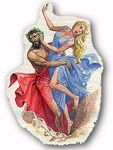This article could use a cleanup in order to be more legible and/or presentable. Please help improve this article in any way possible. Remember to follow our editing guidelines when improving existing articles. If you can improve this page, please edit it (Adding headers and subheaders, simplifying sentences, etc) or help by discussing possible changes.
If you need help with wiki markup, see the wiki markup page. If you want to try out wiki markup without damaging a page, why not use the sandbox?
In Greek mythology, Persephone (/pərˈsɛfəni/, per-seh-fə-nee; Greek: Περσεφόνη), also called Kore (/ˈkɔəriː/; "the maiden") or Cora, is the daughter of Zeus and the harvest goddess Demeter. She is the Greek Goddess of Spring Growth, and is the queen of the underworld.
The Greek horae of Growth Auxesia is also sometimes thought to be one of her titles.
Myths & Legends
Persephone as a vegetation goddess and her mother Demeter were the central figures of the Eleusinian mysteries that predated the Olympian pantheon and promised the initiated a more enjoyable prospect after death.
The origins of her cult are uncertain, but it was based on very old agrarian cults of agricultural communities.
Persephone was commonly worshipped along with Demeter and with the same mysteries. To her alone were dedicated the mysteries celebrated at Athens in the month of Anthesterion. In Classical Greek art, Persephone is invariably portrayed robed, often carrying a sheaf of grain. She may appear as a mystical divinity with a sceptre and a little box, but she was mostly represented in the process of being carried off by Hades.
Abduction into the Underworld
Persephone was married to Hades, the god-king of the underworld. Homer describes her as the formidable, venerable majestic princess of the underworld, who carries into effect the curses of men upon the souls of the dead.
The myth of her abduction represents her function as the personification of vegetation, which shoots forth in spring and withdraws into the earth after harvest; hence, she is also associated with spring as well as the fertility of vegetation.
In the oral tellings of the story, rather than the Orphic written sources, the Chthonic gods Zagreus and Melinoe are said to have been concieved by Hades and Persephone when they mated in the form of snakes.[1]
Powers & Abilities
As the goddess of springtime, underworld, flowers, vegetation and Queen of the Underworld, Persephone is a very powerful goddess. She rules the Underworld alongside with her husband (who is also her uncle), Hades.
- Enhanced Strength
- Immortality
- Supernatural Beauty
- Supernatural Aura Presence
- Shapeshift
- Human Morphing
- Animal Morphing
- Advanced Telekinesis
- Necromancy
- Death Sense
- Mediumship
- Reanimation
- Summoning (deceased souls and/or corpses)
- Soul Manipulation (limited)
- Spring Manipulation (limited)
- Flower Manipulation
- Underworld Lordship
- Communing
- Afterlife Manipulation
- Afterlife Transport
- Afterlife Prevention
- Necroscience
- Spell Casting
- Telepathy
Gallery
References
- ↑ Bell, Malcolm (1981). Morgantina Studies, Volume I: The Terracottas. pp. 89, 90, 106, 107, 254.
| Deities in Greek mythology | |
|---|---|
| Protogenoi | Chaos • Gaia • Tartarus • Uranus • Erebos • Nyx • Aether • Hemera • Eros • Oceanus • Pontus • Thalassa |
| Titans | Atlas • Cronus • Mnemosyne • Prometheus • Rhea • Tethys • Themis • Metis • Hecate • Eos • Helios • Selene |
| Twelve Olympians | Zeus • Hera • Demeter • Hestia • Poseidon • Ares • Artemis • Apollo • Athena • Hermes • Hephaestus • Aphrodite • Dionysus |
| Daemones | Bia • Dike • Eris • Hebe • Hygieia • Hypnos • Nemesis • Nike • Phobos • Poena • Soteria • Thanatos |









